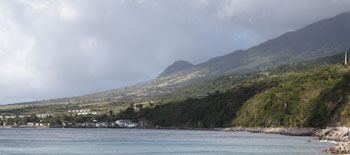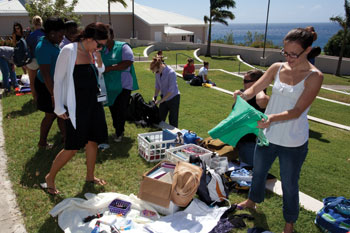Greetings from St. Kitts
Ross University School of Veterinary Medicine in St. Kitts, West Indies, would have you know that there's more to the school than the idyllic scenery.
The for-profit institution has invested heavily in technology, remodeled or built new infrastructure, and created a vertically and horizontally integrated curriculum. For its efforts, Ross was granted full accreditation by the AVMA Council on Education in early March (see JAVMA, April 1, 2011).


Driven to success
Ross came from humble beginnings (see story), but starting in the early 2000s, the veterinary school made gains in a number of areas in its pursuit of COE accreditation.
- The number of full-time faculty more than doubled, from 30 to 77, in seven years.
- The total number of students increased 20 percent from 2004-2009; the number of students graduating during that time increased 9 percent.
- The student population now includes 21 percent underrepresented minorities.
- The students' pass rate on the North American Veterinary Licensing Examination rose from 88 percent in the 2005-2006 academic year to 94 percent in the 2009-2010 academic year.
- The Veterinary Teaching Hospital switched to an electronic record-keeping system a little more than a year ago. A few years earlier, the radiology department switched to a digital storage system for radiographic, ultrasonographic, and other diagnostic images.
- The clinical caseload at the veterinary teaching hospital has increased fivefold since 2003.
- The number of collaborations on research projects with other institutions and agencies has increased from five to 63 since 2006.
It's not by coincidence that many of the advances have taken place under Dean David J. DeYoung's tenure. He was recruited in April 2003 from North Carolina State University College of Veterinary Medicine, where he was associate dean and director of veterinary medical services.
"I had worked with Ross students in the clinic at North Carolina State and I really wanted to focus my time on education, and I saw opportunities here to make significant changes in the way veterinary education is delivered," Dean DeYoung said.

A major tool at Dean DeYoung's disposal has been the school's stable income, which is largely derived from tuition. Students tuition and fees range from $15,353 to $15,802 for each of the first seven semesters, then from $19,168 to $19,537 for the eighth through 10th semesters; these figures do not include housing and other living expenses.
"That's a strength but also a weakness. If (enrollment) declines you don't have other areas to offset that," the dean said. "We can generally—because we're tuition-based—predict what our budgets are and manage our budgets without having a legislature to make those decisions."
Building for the future
Ross is owned by DeVry Inc., one of the largest publicly held, international, higher educational organizations in North America. Dean DeYoung said the company believes in reinvesting in its programs to ensure quality of education. Facilities, faculty, and technology are part of that.
Just three years ago, the cafeteria at Ross was turned into research and clinical skills laboratories. The student union, complete with a new cafeteria, coffee shop, and balcony overlooking the Caribbean Sea, opened in January 2010. And work has just wrapped up on the new large animal complex. The 20,660-square-foot complex features three facilities: a large animal teaching center, medical records building, and large animal isolation unit.
Construction of that complex came on the heels of a 1,550-square-foot expansion of the anatomy museum, which provided more computer laboratory space and space for students to study preserved anatomic specimens and prepare for anatomy courses. Currently, Ross is in the midst of renovating the on-campus residences for first-semester students.
The veterinary school is now in the middle of implementing its 10-year Campus Master Plan, which will guide future development.

"We have a 55-acre campus in which we need to strategically decide where we will locate any new facilities," Dean DeYoung said. "The 10-year plan involves exploring everything from wind generation and maintenance to campus parking and green areas. Immediately, we're looking to build two facilities here in the next couple years. We're not looking to take 10 years to do that."
In the first week of February, a coordinating team of representatives from DeVry, Ross University, and consulting firms spent four days focused on further development of the campus master plan. Dr. DeYoung said in the near future, the school is looking to build a new veterinary teaching hospital, clinical skills and communications laboratory, and necropsy facility, this time with an amphitheater. The hope is to start on one of the buildings by July, he said.
"We also need to expand our research space, as the program is growing by leaps and bounds," Dean DeYoung said. "The current clinical skills lab will be transformed into research space. In new facilities, we're planning for more-flexible space because our research now involves species we never anticipated, such as zebrafish and tilapia. We're also looking at building a larger marine lab so we can house turtles and tilapia to support our research in those areas."